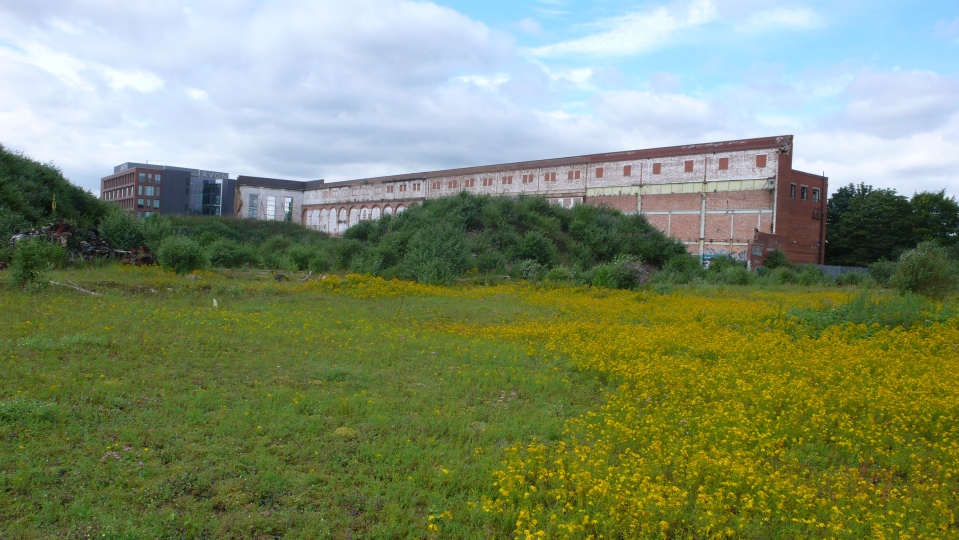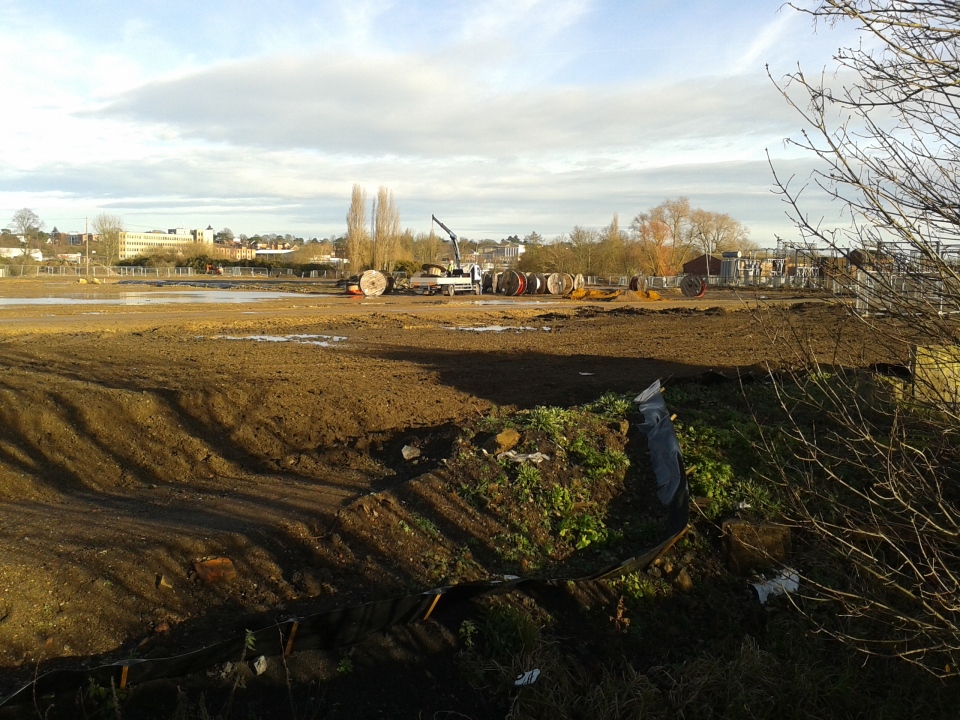All human activities can potentially have an impact on the biodiversity of the local environment in which they occur. That impact can be positive or negative, depending upon how the activity is managed, how impact is mitigated, and the metrics that we use to measure the effects that are occurring. This is particularly true of large infrastructure developments such as big buildings, housing developments, roads, and, a category close to home for me at the moment, new university campuses.
I’ve written before about the University of Northampton’s plans to build the new Waterside Campus on brownfield land close to the River Nene, here and here. It’s a huge project, likely to cost in excess of £330 million on a site covering about 20 hectares.
As you might imagine, such an ambitious scheme has not been without its controversies and there is much debate within the university about changes to how we work and interact with colleagues and students, provision of teaching and research spaces, etc. There’s also been much discussion within the town, though the general feeling amongst the public (as far as I perceive it) is that bringing the university closer to the centre of Northampton will provide a much-needed economic boost and add significantly to the town’s life.
But what effect will such a development have on the wildlife in and around this peri-urban site, given that it’s in the middle of the Nene Valley Nature Improvement Area and very close to internationally important bird sites?
Over the past few months, together with my colleague Dr Janet Jackson, I’ve been taking part in meetings with the Waterside project’s landscape architects (LUC), other partners from the NIA project board, and the local Wildlife Trust. We’ve been discussing the current plans for the green infrastructure of the campus and thinking about how these can be enhanced. It’s been a fascinating process as initial disagreements have been negotiated towards compromises and additions that everyone is happy with, balancing budgetary, function and space restrictions with habitat creation and landscape enhancement.
There’s too much been discussed to give a full account at this stage, and it’s possible that some details will change over time, but the current Ecology Strategy document produced by LUC shows that there will be more than 10 hectares of habitat creation on the site, including species-rich grassland, woodland patches, brown and green roofs, swales and damp areas, and recreated brownfield habitat. The latter is particularly exciting and something of an experiment, as much of the (albeit limited) current wildlife interest on the site relates to the brownfield element, including the “urban tundra“.
To put the 10 hectares into perspective, the adjacent Wildlife Trust Local Nature Reserve of Barnes Meadow is only 20 hectares in area, so it’s potentially increasing that site by 50%. It’s rare for academic ecologists such as Janet and myself to be able to influence large building developments, so this has been an exciting opportunity for us to make a contribution that (if all goes to plan) will have a positive effect on biodiversity conservation in the Nene Valley.
But how will we know if the Great Waterside Experiment has been a success and that the biodiversity of the new campus is at least as rich, and preferably richer, in species than it was before building took place?
Monitoring of the wildlife is key to this. Fortunately we have some base-line surveys of birds, plants and invertebrates (including bees and butterflies) from before building started that we can compare with later surveys during and after the campus build. That process has already started, and with my colleague Dr Duncan McCollin and with two keen second-year students, Jo and Charlie, we have already completed three winter bird surveys to get a sense of how the current site clearance and ground works is affecting the presence of birds in and around the development, including those using the River Nene. The plan is to continue these surveys up to and after the campus opens in 2018, to give us a data series showing the influence of the campus on bird diversity and numbers.
The initial results are currently being analysed and it appears that the current phase of building has reduced overall bird diversity by about 30%, and that red and amber status birds (of most conservation concern) have been affected more than green status birds, as this figure demonstrates (click on it for a closer view):
These rough figures hide a lot of detail, however. For example, there has been some addition of species in 2014-15 that were not recorded in 2012-13, including Coot, Treecreeper and the amber-status Stock dove. More importantly, some of the amber status birds that we didn’t record on site in 2014-15, we know from additional surveys are still present in habitats within 500 metres of the development, for example Dunnock, Green woodpecker, and Bullfinch. Similarly, red status birds such as resident Starling, and winter migrant Fieldfare and Redwing occur within at least one kilometre of the site. Hopefully as the building work progresses towards completion these (and other) species will return, so at the moment we’re not too concerned by their disappearance from the site.
Later in the spring we will conduct a couple of breeding bird surveys, and continue surveying for the next few years until the campus opens in 2018. Only then will we see exactly how successful our influence has been. In the mean time I’ll report back as and when we have more data to share.





I am so pleased that you are able to influence the plans and speak up for the birds living around the future campus.
Thanks Emily, let’s hope it’s successful.
Hi Jeff
Thank you for sharing your and your colleagues’ fascinating findings. It is encouraging that you speak up for protecting the wider environmental interests of wildlife and birds near the proposed new campus.
However, it occurs to me that in the urgent flight to the new campus we may be discarding our existing moral and social obligations to the environment and wildlife at Park and Avenue Campuses, which may, when balanced, in fact amount to an overall environmental depredation.
I wondered whether it would be possible to undertake a study to examine and measure in a comparative way, the environmental and ecological losses as well as the economic costs caused by the demolition of perfectly serviceable buildings only for them to be replaced by high density housing as against the proposed new building.
Best
James
Hi James – thanks for your comments. An environmental and economic audit of costs and benefits of the move would be a huge undertaking as we’d need to factor in a lot of different measures, including energy efficiency of new buildings, recycling of materials from old buildings, use of materials and resources in the new builds, etc., etc. That’s no small task.
An ecological audit, on the other hand, would be more straightforward. We have species lists for a number of groups of organisms (birds, bees, plants, fungi) from both campuses and could certainly do and before-and-after assessments. That’s a great idea and I’ll talk to colleagues about it.
Regards,
Jeff
Hi Jeff
Tat is great and it would be marvelous to see the results at least of the ecological audit and its comparison with Waterside.
Best
James
Those are very interesting points, thank-you. Having looked at the consultation documents about the new development I gather many people are concerned about the Forest School and what will happen to that. Also related, will Bradlaugh Fields nature reserve continue to benefit as it has done for many years now from visits by University researchers, after the move into the town centre?
Thanks! I can’t comment on the Forest School as it’s not run from my department, it’s School of Education. But there ought to be scope to run something similar at Waterside.
Regarding Bradlaugh Fields, yes, we’d still hope to use it as one of our field sites for future research and student field trips.
It is good to see that ecology academics (and students) are involved in protecting the biodiversity of this site. I am always concerned when I hear about ‘mitigation’ and ‘habitat creation’ in building projects – but base line surveys and monitoring throughout and after the build will provide great evidence on the success of these measures.
Thanks Catherine, I agree. And it’s not often such analyses are followed through and then published. All being well, by about 2020 we will have a good case study published.
I find it heartening that more and more scientists, like you, are becoming committed to ‘living with wildlife’ and contribute to trying to save/create habitats etc.
Thanks erikleo, we are doing what we can!
Pingback: The uneasy academic and the importance of dipping outside your discipline: reflections on The Urban University conference | Jeff Ollerton's Biodiversity Blog
Pingback: Six bees, one stone: recent pollinator-related talks and workshops | Jeff Ollerton's Biodiversity Blog
Pingback: Engaging students with the fundamentals of biodiversity (1) – “The Taxonomy of Gastronomy” | Jeff Ollerton's Biodiversity Blog
Pingback: The Biodiversity Impact of Waterside Campus: an interim report on the bird surveys | Jeff Ollerton's Biodiversity Blog
Pingback: The impact of building a new university campus on urban bird diversity and abundance: a seven-year study | Jeff Ollerton's Biodiversity Blog